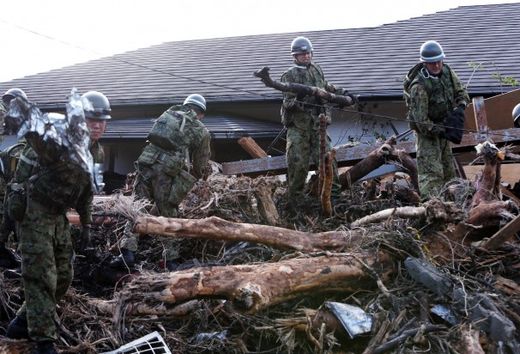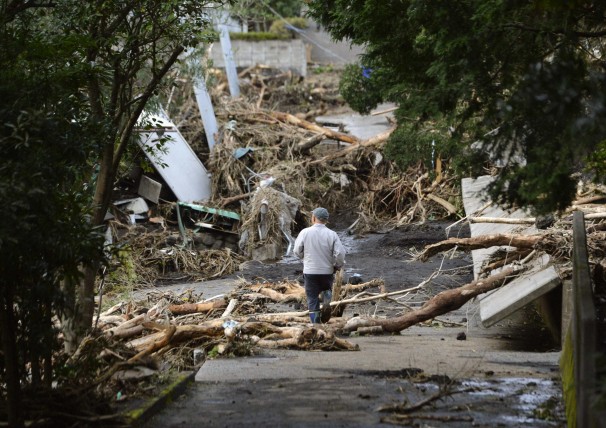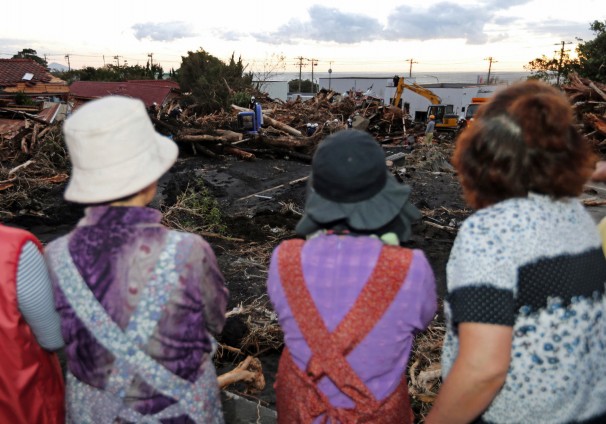
It is the greatest rainstorm to occur on Oshima, populated by 8,200 people, since records began in 1991 reports the AP. It also twice the entire average rainfall for the month of October, notes the Wall Street Journal.
"People on this island are somewhat used to heavy rainstorms, but this typhoon was beyond our imagination," Yutaka Sagara, an island resident, told the AP.
Incredibly, 17 inches (426 mm) fell in 4 hours and nearly 5 inches in one hour.
Those are unfathomable rainfall rates and, thus, it is no surprise they led to destructive mudslides and fatalities.
At least 17 people are dead from the typhoon and 45 to 50 missing according to wire reports. 16 of the 17 casualties occurred on Oshima.
283 homes were damaged or destroyed on Oshima, the AP says.
"The storm sent large volumes of earth down mountainsides and caused rivers to burst their banks," reports the BBC. "Television footage showed the remains of wooden homes buried in mud and covered in debris."
Why so much rain?
Typhoon Wipha, while in a weakening phase, was transporting a tremendous amount of tropical moisture northward. In addition, it was merging with a mid-latitude cold front, which expanded and enhanced its moisture plume.

Five to 10 inches of rain fell in many areas and, in Tokyo, winds gusted up to 72 mph. Sustained winds reached 47 at Tokyo International Airport (Haneda), which is tropical storm force.
"More than 500 flights at Tokyo's Haneda and Narita airports were canceled, and thousands of schools closed," Reuters reports. "Bullet train services were halted but resumed by Wednesday afternoon"
Nearly 10 inches of rain fell near the nuclear plant in Fukushima, which has experienced recent problems with radioactive leaks. But Tokyo Electric Power Corporation said the typhoon caused no problems according to Reuters.

The Joint Typhoon Warning Center (JTWC) is monitoring tropical storm Francisco, which has the potential to rapidly intensify and grow into a powerful typhoon.
The JTWC forecasts its peak winds to increase from 40-45 mph today to 125 mph this weekend. If it affects Japan, it would most likely be during the early to middle part of next week and would probably be starting to weaken, but still a formidable storm.
33 inches of rain in 24 hours, in perspective
While the 33 inches of rain put down by Wipha in Oshima in one day is an obscene amount of rain, it is not an international record. This amount has been exceeded both in the U.S. and elsewhere.
Christopher Burt of Weather Underground notes the U.S. 24-hour rainfall record is 43 inches in Alvin, Texas from July 25-26, 1979 (from tropical storm Claudette, AccuWeather reports).
As for the greatest 24-hour rainfall total globally, it's an amazing 72 inches, says AccuWeather:
The greatest 24-hour rainfall amount in the world is nearly 72 inches at Foc-Foc, La Reunion Island, an island located in the Indian Ocean to the east of Madagascar, Jan. 7-8, 1966. The rain was unleashed by a tropical cyclone churning in the Indian Ocean.
Jason Samenow is the Capital Weather Gang's chief meteorologist and serves as the Washington Post's Weather Editor. He earned BA and MS degrees in atmospheric science from the University of Virginia and University of Wisconsin-Madison.



Reader Comments
to our Newsletter